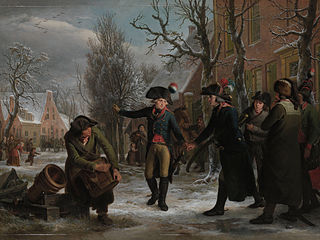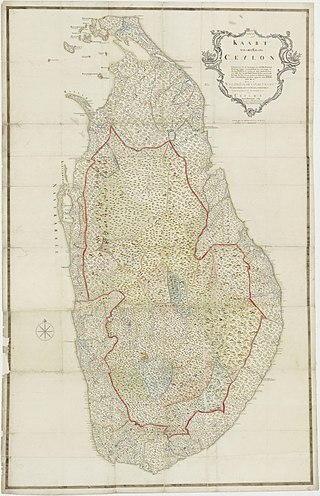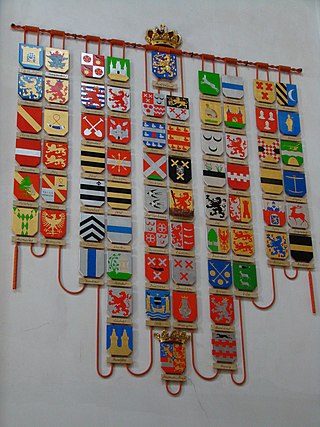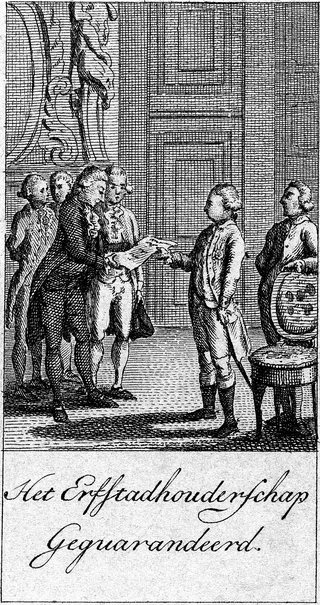Related Research Articles

William I was king of the Netherlands and grand duke of Luxembourg from 1815 until his abdication in 1840.

William III, also widely known as William of Orange, was the sovereign Prince of Orange from birth, Stadtholder of Holland, Zeeland, Utrecht, Guelders, and Overijssel in the Dutch Republic from the 1670s, and King of England, Ireland, and Scotland from 1689 until his death in 1702. As King of Scotland, he is known as William II. He ruled Britain and Ireland alongside his wife, Queen Mary II, and their joint reign is known as that of William and Mary.

The United Provinces of the Netherlands, officially the Republic of the Seven United Netherlands, and commonly referred to in historiography as the Dutch Republic, was a confederation that existed from 1579 until the Batavian Revolution in 1795. It was a predecessor state of the present-day Netherlands, and the first independent Dutch state. The republic was established after seven Dutch provinces in the Spanish Netherlands revolted against Spanish rule, forming a mutual alliance against Spain in 1579 and declaring their independence in 1581. It comprised Groningen, Frisia, Overijssel, Guelders, Utrecht, Holland, and Zeeland.

William V was Prince of Orange and the last Stadtholder of the Dutch Republic. He went into exile to London in 1795. He was furthermore ruler of the Principality of Orange-Nassau until his death in 1806. In that capacity he was succeeded by his son William.

Princess Wilhelmina of Prussia was the consort of William V of Orange and the de facto leader of the dynastic party and counter-revolution in the Netherlands. She was the daughter of Prince Augustus William of Prussia and Duchess Luise of Brunswick-Wolfenbüttel. Wilhelmina was the longest-serving Princess consort of Orange.

The Batavian Revolution was a time of political, social and cultural turmoil at the end of the 18th century that marked the end of the Dutch Republic and saw the proclamation of the Batavian Republic.

Jonkheer Jan Willem Janssens GCMWO was a Dutch nobleman, soldier and statesman who served both as the governor of the Dutch Cape Colony and governor-general of the Dutch East Indies.

Dutch Ceylon was a governorate established in present-day Sri Lanka by the Dutch East India Company. Although the Dutch managed to capture most of the coastal areas in Sri Lanka, they were never able to control the Kingdom of Kandy located in the interior of the island. Dutch Ceylon existed from 1640 until 1796.

In the Vlieter incident on 30 August 1799, a squadron of the Batavian Navy, commanded by Rear-Admiral Samuel Story, surrendered to the British navy. The incident occurred during the Anglo-Russian invasion of Holland. It occurred in the tidal trench between Texel and the mainland that was known as De Vlieter, near Wieringen.

In the history of the Dutch Republic, Orangism or prinsgezindheid was a political force opposing the Staatsgezinde (pro-Republic) party. Orangists supported the Princes of Orange as Stadtholders and military commanders of the Republic, as a check on the power of the regenten. The Orangist party drew its adherents largely from traditionalists – mostly farmers, soldiers, noblemen and orthodox Protestant preachers, though its support fluctuated heavily over the course of the Republic's history and there were never clear-cut socioeconomic divisions.
Henry William Bentinck was a Dutch-born military officer, planter and colonial administrator. He served as Governor of Saint Vincent (1802–1806), Essequibo Demerara (1806–1812), and Berbice (1814–1820).

The Invasion of Ceylon was a military campaign fought as a series of amphibious operations between the summer of 1795 and spring of 1796 between the garrison of the Batavian colonies on the Indian Ocean island of Ceylon and a British invasion force sent from British India. The Dutch Republic had been a British ally during the French Revolutionary Wars, but was overrun by the French Republic in the winter of 1794 and reformed into the client state of the Batavian Republic. The British government, working with the exiled Stadtholder William of Orange, ordered the seizure of Batavian assets including colonies of the former Dutch Empire. Among the first territories to be attacked were those on the coast of the island of Ceylon, with operations initially focused on the trading port at Trincomalee.

Marquis of Veere and Flushing is one of the titles of the kings and queens of the Netherlands. It was originally a Dutch title of nobility referring to the cities of Veere and Vlissingen, in the southwestern Netherlands. Holy Roman Emperor Charles V created the title in 1555 for his distant relative, Maximilian of Burgundy, who had by then ruled as Lord of Veere. After being held by the kings of Spain and England and claimed by the kings in Prussia, it definitively passed to the House of Orange-Nassau.

The siege of Zutphen was an eleven-day siege of the city of Zutphen by Dutch and English troops led by Maurice of Nassau, during the Eighty Years' War and the Anglo–Spanish War. The siege began on 19 May 1591 after a clever ruse by the besiegers. The city was then besieged for eleven days, after which the Spanish garrison surrendered.

The Invasion of the Cape Colony, also known as the Battle of Muizenberg, was a British military expedition launched in 1795 against the Dutch Cape Colony at the Cape of Good Hope. The Dutch colony at the Cape, established and controlled by the United East India Company in the seventeenth century, was at the time the only viable South African port for ships making the journey from Europe to the European colonies in the East Indies. It therefore held vital strategic importance, although it was otherwise economically insignificant. In the winter of 1794, during the French Revolutionary Wars, French troops entered the Dutch Republic, which was reformed into the Batavian Republic.

The Act of Guarantee of the hereditary stadtholderate was a document from 1788, in which the seven provinces of the States General and the representative of Drenthe declared, amongst other things, that the admiralty and captain-generalship were hereditary, and together with the hereditary stadtholderate would henceforth be an integrated part of the constitution of the Dutch Republic. Moreover, members of the House of Orange-Nassau would have the exclusive privilege to hold the office. The Act was in force until the Batavian Republic was established in 1795.

Jurriaan François de Friderici was a Dutch military officer and plantation owner. He served as Governor of Suriname from 1790 until 1802. In the 1770s, he was involved in the Boni Wars. In 1799, Suriname was conquered by Great-Britain, however de Friderici changed allegiance and remained governor. He was dismissed in 1802 when the colony was returned to the Batavian Republic.

Willem Benjamin van Panhuys was a Dutch military officer, planter, and colonial governor. He served as Governor of Suriname from 27 February 1816 until his death on 18 July.
Antony Beaujon also Anthony was a Dutch and British civil servant and politician in Guyana. He served as Governor of Demarara from May 1795 until 5 July 1802, and as Lieutenant governor of Demerara and Essequibo from 13 August 1804 until his death.
Johann Rudolf Lauffer was a Swiss-born Curaçaoan soldier, colonial administrator and businessman. He became Director of Curaçao and Dependencies after a military coup d'état on 1 December 1796 and served until 13 January 1803.
References
- Israel, J.I. (1995), The Dutch Republic: Its Rise, Greatness and Fall, 1477-1806 , Oxford University Press, ISBN 0-19-873072-1 hardback, ISBN 0-19-820734-4 paperback, p. 1127
- (in Dutch)Woelderink, B. and Muij-Fleurke, H.J. de (2005) Inventaris van de archieven van stadhouder Willem V (1745–1808) en de Hofcommissie van Willem IV en Willem V (1732–1794) , Uitgeverij Verloren, ISBN 90-6550-890-2, p. 102 (No. 1007)
- Andrew Porter (2001) The Oxford History of the British Empire: Volume III: The Nineteenth Century , Oxford University Press, ISBN 0199246785 Paperback, p. 374

